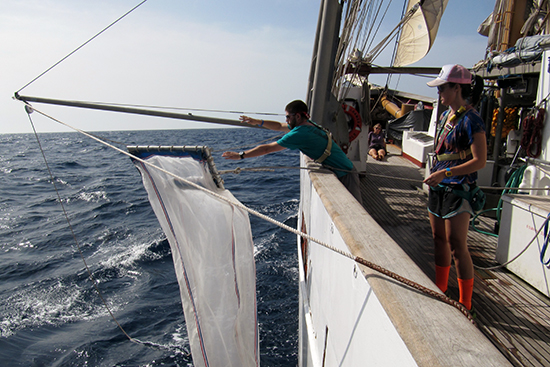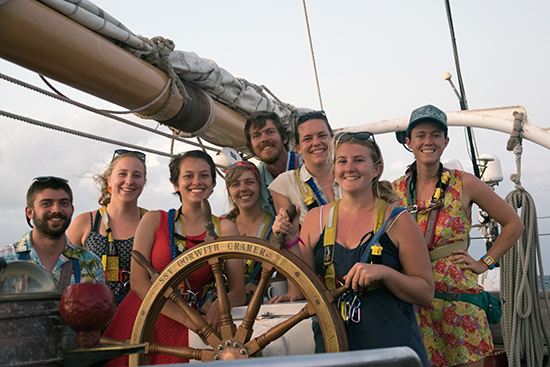Studying Out on the Open Ocean
Two marine science majors’ SEA Semester experience

Students deployed Neuston nets, which are used to collect organisms that live in the ocean’s top—or neuston—layer. Photo by Amy Siuda
Siya Qiu didn’t know the difference between a jib and a bowsprit when she decided to spend a semester studying aboard the research vessel SSV Corwith Cramer. But after a six-week voyage that took her from Spain’s Canary Islands to St. Croix in the Caribbean, Qiu (CAS’17), a marine science major, soon became well versed on what it’s like to live at sea. She was joined on the 3,100-mile trip, run by the Sea Education Association (SEA), by fellow marine science major Jeffrey Morgan (CAS’17), as well as two dozen other students, professors, and researchers from other institutions.
“I never heard words like bowsprit before, and especially for me—I’m from China, my first language is Cantonese—it was pretty hard to learn all those words in a few days,” Qiu says. “And we learned how to navigate using a sextant by observing the stars and sun, the same way that Columbus did. The trip was excellent.”
Students in the marine science program are required to participate in the Boston University Marine Program (BUMP) Marine Semester, which sends them to study and research in the field in Boston or Belize or gives them the option to enroll, as Qiu and Morgan did, in SEA Semester’s Oceans & Climate program. The SEA curriculum focuses on examining how the oceans function within the global climate system and evaluating the challenges of—and strategies for—a sustainable future.
“When I started taking oceanography, I remember being surprised to learn that the ocean covers 71 percent of the Earth’s surface and holds 99 percent of the world’s living space,” says Morgan, who signed up for the trip after spending some time on a SEA Semester vessel during a summer. “The first time I traveled with SEA Semester, it wasn’t as intensive as the fall program. I wanted to get the Woods Hole experience and have a longer voyage on the boat.”
The program began in Woods Hole, Mass., in late September, where students spent eight hours a day in academic classes, like advanced oceanographic field methods and ocean science and public policy. Previous sailing experience isn’t a requirement for the trip, so students learned skills like navigation, safety, and weather forecasting while still on land. Finally, they each designed a research project to work on while at sea. The team boarded the 134-foot-long tall ship SSV Corwith Cramer halfway through November, departing from the Canary Islands.
Qiu and her research partner chose to study how phytoplankton, microscopic sea plants that are a food source many fish depend on, respond to climate change in the North Atlantic Ocean. Colder ocean water absorbs more nutrients than warmer ocean water, so when ocean water “mixes,” from waves and storms, nutrients are brought to the top of the ocean, where phytoplankton live, and phytoplankton can feed.
But when air temperature is higher than average—an increasingly frequent phenomenon because of climate change—“surface water becomes much warmer than usual, and deep water still stays cold,” Qiu explains. Higher surface temperature makes the ocean water more stratified, meaning barriers are formed, and the water can’t mix between the layers. Thus, fewer nutrients make it to the surface and phytoplankton can’t get the nutrients they need.
To prove this theory, Qiu and her partner collected water samples every morning while on board the ship to analyze water temperature and phytoplankton cell size, and then, to make their investigation more thorough, they combined these measurements with data collected between 2003 and 2014. They found that in warmer-than-average years, when the ocean’s temperature also increased, phytoplanktons’ size (or biomass) and number decreased. “If the sea’s surface temperature rises further,” Qiu says, “the entire oceanic food chain is at risk of collapse.”

For Morgan’s project, he and his research partner studied another small sea plant, picoplankton. Morgan explains that as the oceans warm, researchers expect to see more picoplankton edge out algae and phytoplankton (which make up the diet of many fish). Algae and phytoplankton get their energy from the sun.
With warming oceans comes an increase in the ratio of nitrogen to phosphorus. Areas with this higher ratio, Morgan says, usually have smaller organisms (such as picoplankton) because they also have very low concentrations of nutrients in the water. Picoplankton are able to live in these areas because they have a small surface area to volume ratio, and then can absorb smaller concentrations of nutrients in the water.
“It would be like looking at a creature who was 2-D versus one that was 3-D,” he says. “The 2-D creature will absorb relatively more stuff for its volume because it needs less to survive. The 3-D creature needs more nutrients and does not absorb the same amount in relation to its counterpart.”
Specifically, Morgan was interested in how picoplankton’s abundance, in relation to other phytoplankton, changed during the ship’s journey. To do this, he and his partner took water samples at 20 different locations to measure the ratio of nitrogen to phosphorus and examined which ratios correlated to the regions of the ocean with known high percentages of picoplankton. They also measured water temperature to confirm if warmer waters really had more small plankton.
He and his research partner found no significant correlations between phytoplankton size and water temperature, and phytoplankton size and ratio of nitrogen to phosphorus. “We didn’t see any correlations for those variables because, simply put, science is hard,” Morgan says. “You go out hoping to see something, but in reality so much can go wrong. For us, it had a lot to do with sampling and analysis limitations and complications, the most prominent being doing science—which is already hard—on a rolling ship with very little equipment.”
The trip wasn’t all research. Qiu says her shipmates made her a special order of English muffins while at sea because she had never tried them before, and they reminded her to take her seasickness medication when the ocean got rocky. Students were assigned around-the-clock shifts to keep watch over the boat, and they learned how to get on without a phone or the internet, although they did write blog posts that they transferred to zip drives and occasionally were able to upload. And towards the end of the six-week sail, the ship finally docked and students visited Dominica Island and St. John’s, where they strolled around some small towns and did some hiking. The SSV Corwith Cramer arrived in St. Croix just before Christmas.
A SEA Semester veteran, Morgan says trips like this are about more than the individual research projects. “The biggest challenge with a new group is trying to find your place,” he says. “SEA Semester allows you to not just learn about yourself and what you’re capable of, but what others around you are capable of with your help.”
Interested in learning more about SEA Semester? Attend an information session on Wednesday, March 16, at 4 p.m. in the College of Arts & Sciences Room 221.
Comments & Discussion
Boston University moderates comments to facilitate an informed, substantive, civil conversation. Abusive, profane, self-promotional, misleading, incoherent or off-topic comments will be rejected. Moderators are staffed during regular business hours (EST) and can only accept comments written in English. Statistics or facts must include a citation or a link to the citation.